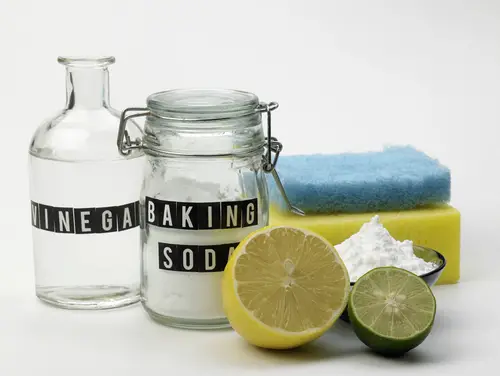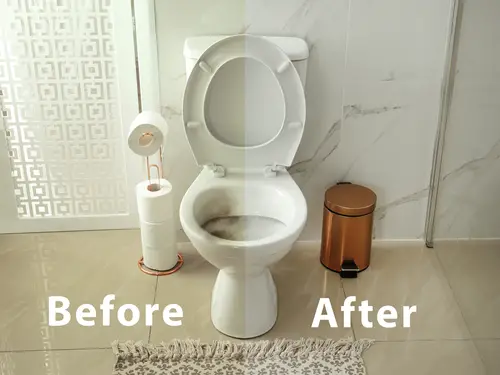Have you been struggling to keep your toilet clean and smelling fresh? We have a simple trick that not only ensures the hygiene of your toilet but also saves you money! Let’s dive into the details.
The Bottle Method: An Easy and Effective Way to Clean the Toilet Bowl
Before we get started, there’s a small step you need to take before bed. Pour a handful of baking soda and a small amount of white vinegar into the toilet bowl. The foaming effect created by these two ingredients will naturally remove dirt from the walls of the bowl. Leave it on for 15 minutes or overnight, and then scrub gently with a toilet brush to remove debris and odors.
Now, let’s move on to the bottle method. This technique involves placing a small bottle in the toilet cistern to clean the bowl every time you flush. It’s quick, easy, and inexpensive!
Here’s what you’ll need:
– A half-quart plastic bottle
– Liquid soap
– 1 cup of white vinegar
Pour the liquid soap into the bottle, add the white vinegar, and close the bottle. Shake it well to mix the soap and vinegar. Pierce the top of the plastic cap and open the tank cap. Insert the bottle into the tank, making sure it doesn’t block the flushing mechanism.
Every time you flush, the cleansing mixture will act on the walls of the toilet bowl, keeping it clean and white. This technique not only disinfects your toilet but also lightly perfumes your bathroom. Plus, it helps reduce water consumption since the tank holds less water. It’s a win-win solution that everyone should consider using!
Unclog Your Toilet with a Plastic Bottle
Got a clogged toilet but no plunger? A plastic bottle can come to your rescue! Follow these simple steps:
1. Cut off the bottom of a quart bottle using a knife or scissors, and keep the cap.
2. Place the cut bottom of the bottle on the bottom of the bowl.
3. Move the bottle back and forth as if you were using a suction cup. If the blockage isn’t significant, this technique should do the trick.
How to Clean the Bottom of the Toilet with a Plastic Bottle

Plastic bottles are not only useful for unclogging toilets but also for cleaning the bottom of the bowl. Here’s how:
1. Heat some water and add a natural cleaning agent like white vinegar or a mixture of lemon juice and baking soda.
2. Pour the solution into a plastic bottle and close it.
3. Pierce the plastic cap of the bottle.
4. Aim the neck of the bottle at the bottom of the toilet and gently squeeze it to spray the cleaning water onto the surface.
5. Scrub with a toilet brush and flush. Repeat if necessary.
Natural Descaling Solutions for Your Toilet

If you’re looking for natural and environmentally friendly alternatives to harsh chemical cleaners, there are several options for descaling your toilet. Here’s a recipe you can try:
1. Mix water, 2 tablespoons of baking soda, 1 tablespoon of coarse salt, and 1/4 glass of lemon juice.
2. Pour the solution into a small plastic bottle that fits in the toilet cistern.
3. Stir well to combine the ingredients.
4. Place the bottle in the tank and close it.
5. Let it soak for 30 minutes.
6. Flush the toilet. Over time, the lime scale should break down as you continue to flush.
A Plastic Bottle, Your Toilet’s Best Friend
Who knew a simple plastic bottle could solve so many toilet problems? By using the bottle method, you can easily keep your toilet clean, save money on water consumption, and even unclog the toilet without a plunger. It’s a budget-friendly and effective solution for maintaining a sparkling clean toilet.

This Site Was Inspired By An Interest in Protecting the Environment:
We had the privilege and joy of learning from Dr. Charlie Stine who instilled a love for the natural world through incredible field trips with the Johns Hopkins Odyssey Certificate program in Environmental Studies. At the time, the program was endorsed by the Maryland Department of Natural Resources. Sadly, after Dr. Stine retired, the program was phased out. We hope that we honor his legacy by shining a bright light on environmental issues and sharing good news about the success of various conservation programs when possible.